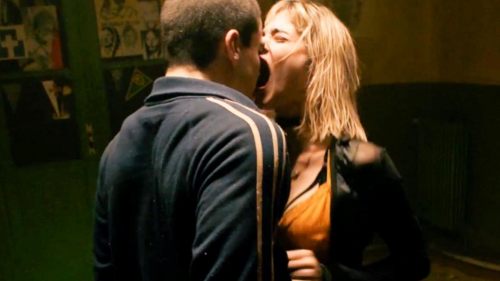Fantastic Fest Review: CLIMAX Is Gaspar Noe’s Infernal Comedy
Dante once envisioned himself being led by Virgil and Beatrice through Hell, into Purgatory, and finally to glory. In Climax, Gaspar Noe perversely inverts that journey, pushing us from a brief flash of paradise into an infernal nightmare. This movie performs a mesmerizing dance that drives characters and audience alike straight into a whirling hellscape — and it is incredible.
Climax is set almost entirely in a dingy, closed-down school somewhere in France. A 20-member dance company, assembled shortly before the events of the film, is rehearsing a show. The dancers are magnificent, vibrantly alive and pulsing with energy. Noe’s camera captures them in wide shots, often looking directly down at the routines, so the performers are abstracted into form and movement.
The camera twists and glides between the dancers like it is one of them. Everyone gets a moment, but even with individual solos there’s a sense of total unity. When the dance ends — after what could have been five minutes, or twenty — the company is ecstatic, and rightly so.
Then someone drugs the sangria. Party buzz becomes paranoia. Sexual and political conflicts erupt. One woman locks her young son in an engineering closet in an awful bid to keep him safe. Some people keep dancing. Even when people aren’t technically reacting to music, dance informs all the physical performances.
Before Climax really begins to burn, people split off into pairs. They hang out around the performance space, creating and enforcing alliances. They drink and complain about people not drinking; some shit-talk the other dancers, laugh about who they want to fuck and who they hate, and how, and why.
Those conversations serve as Noe’s version of character definition, but they work just fine. The actors, in combination with hair, makeup, wardrobe, and choreography, give each dancer has a distinct identity. We’re actually introduced to the performers early on, in a block of videotaped interviews during which each dancer is asked about ambitions, and fears. These conversations are a lot of information to digest in a short time, with no connection to a story. It’s easy to miss a lot of it. These details, however, are reflected in the behavior of each person after the drugs kick in.
Increasingly vicious and hysterical battles break out between factions. Noe leverages all his familiar tricks to create an oppressive, suffocating air. There are blocky intertitles (sample text: “life is a collective impossibility”) and strobing credits; upside-down imagery; color-coded spaces; and raw violence and sexuality. Noe’s visual language is straightforward, but brutally effective.
Scenes never resolve. While Noe’s camera floats from one encounter to another, there aren’t many recognizable scene breaks at all. There’s certainly no conventional conclusion to any segment — only a constantly escalating sense of movement. The beat never drops. Someone is almost always screaming but we rarely see who, or why. No one seems to try to stop it. The ones who are able to just keep moving.
While not as overtly explicit or nasty as some of Noe’s previous work, Climax may be his most cynical film. It suggests a repeating pattern of genuine ecstasy giving way to horror, and the structure implies that the horror always dominates. And yet this is highly accomplished, even masterful filmmaking that is as exuberant as the action is monstrous. Noe’s most impressive feat may be making hell look so good.



